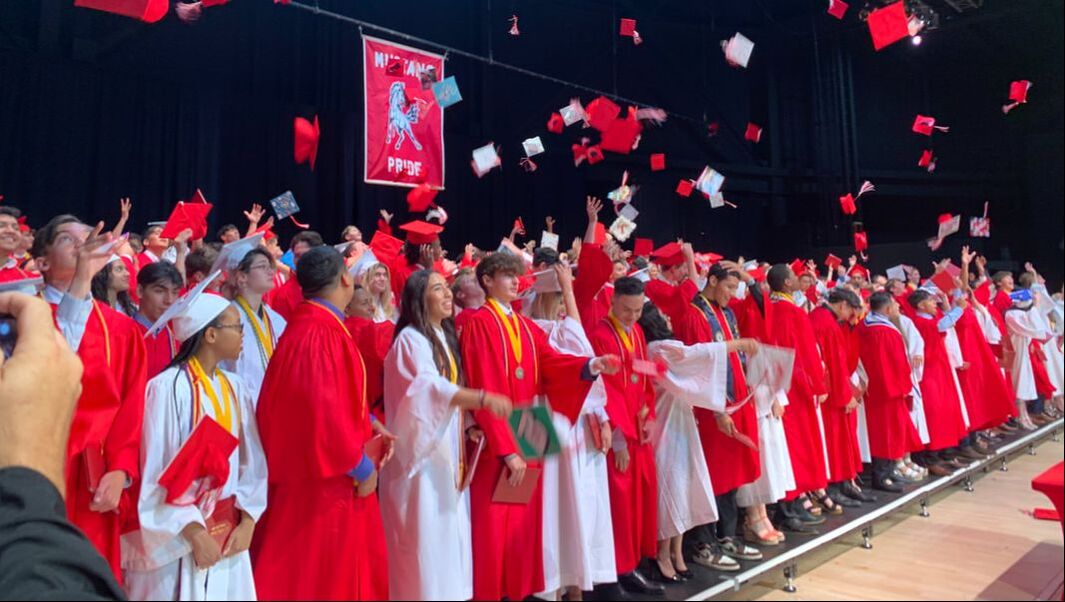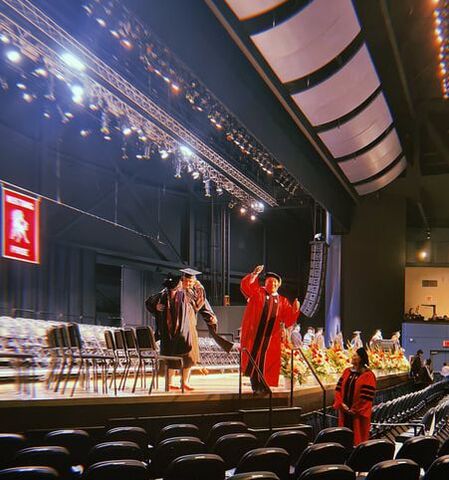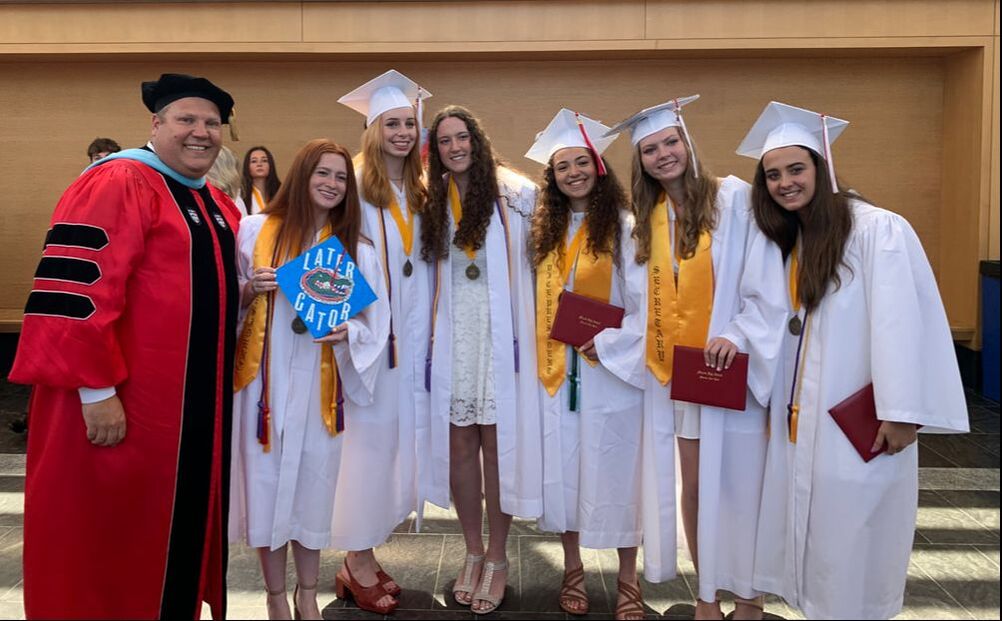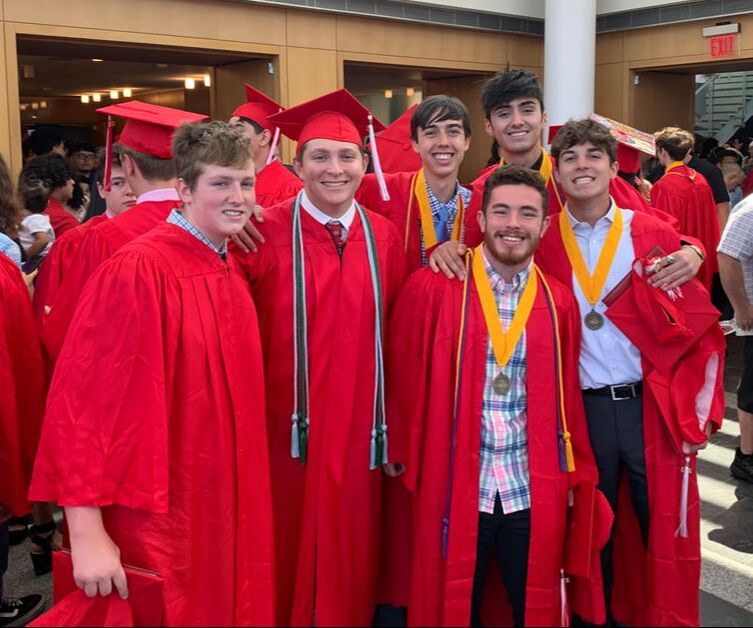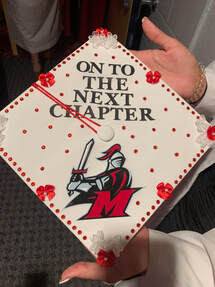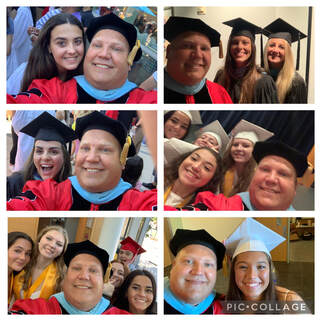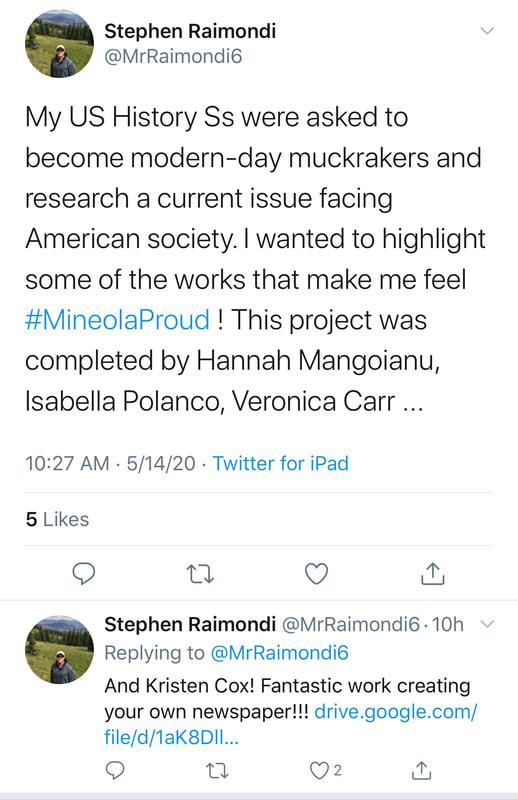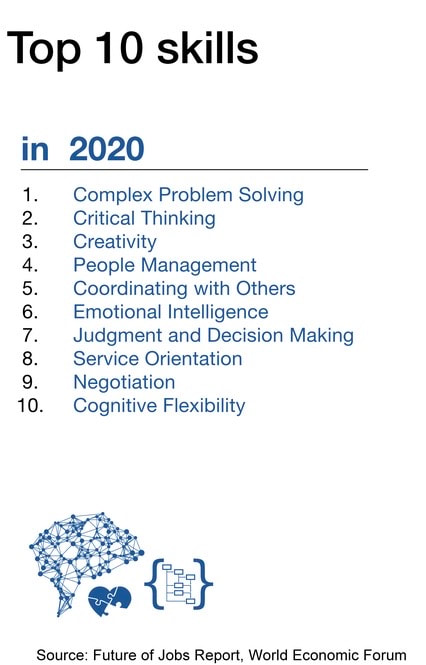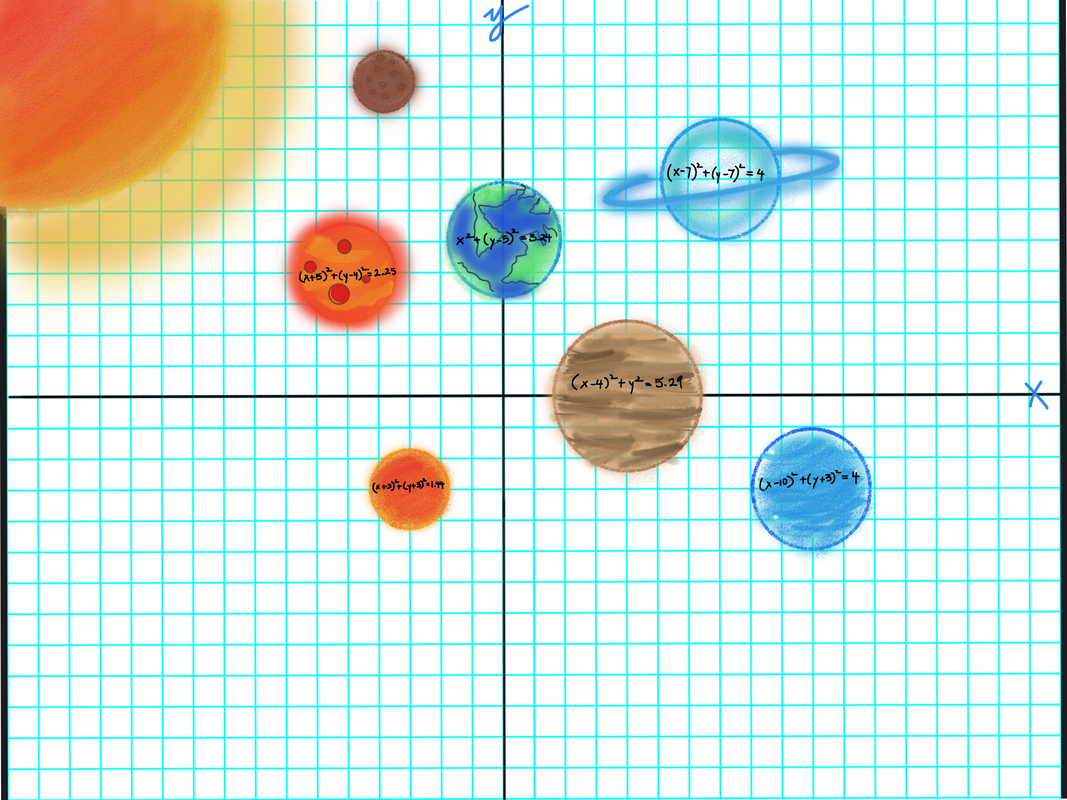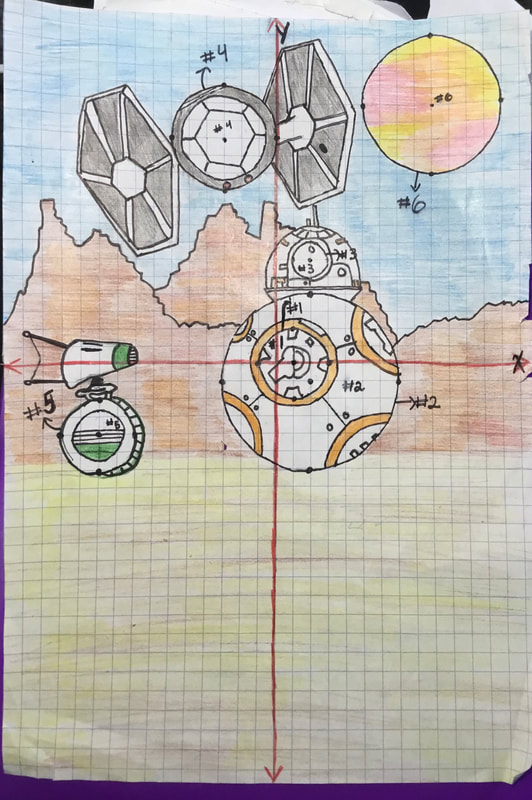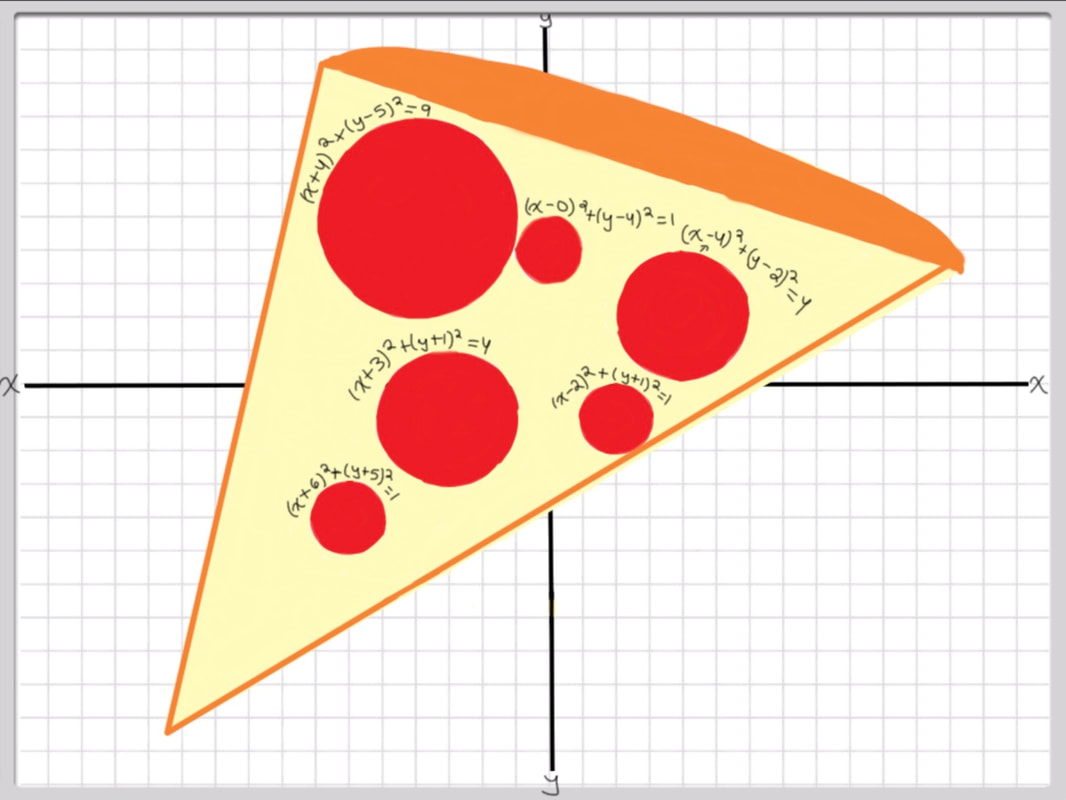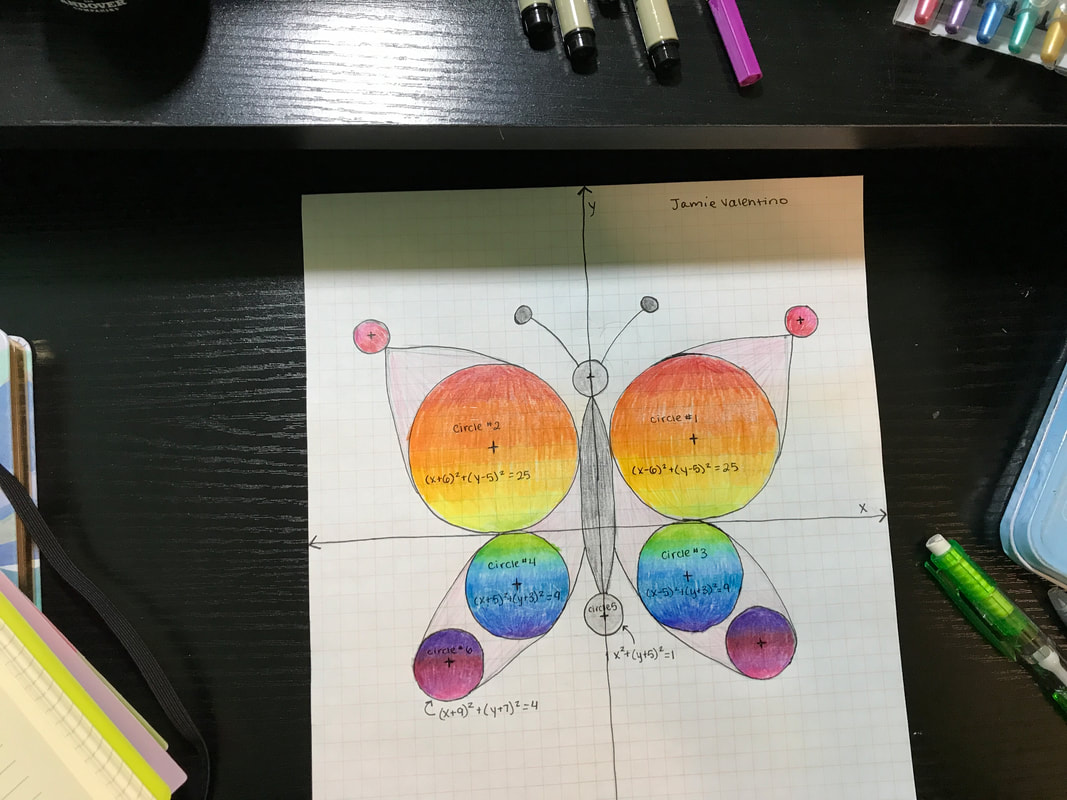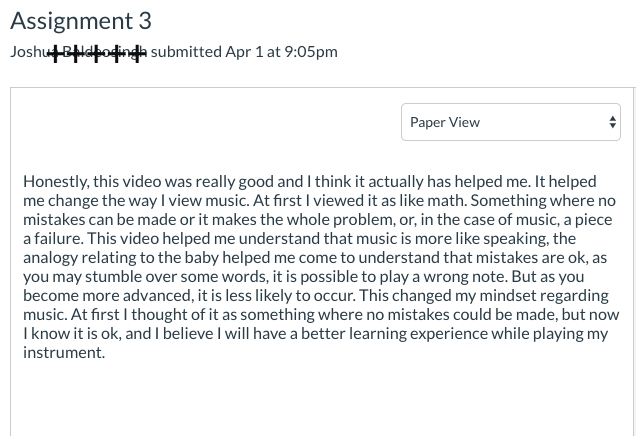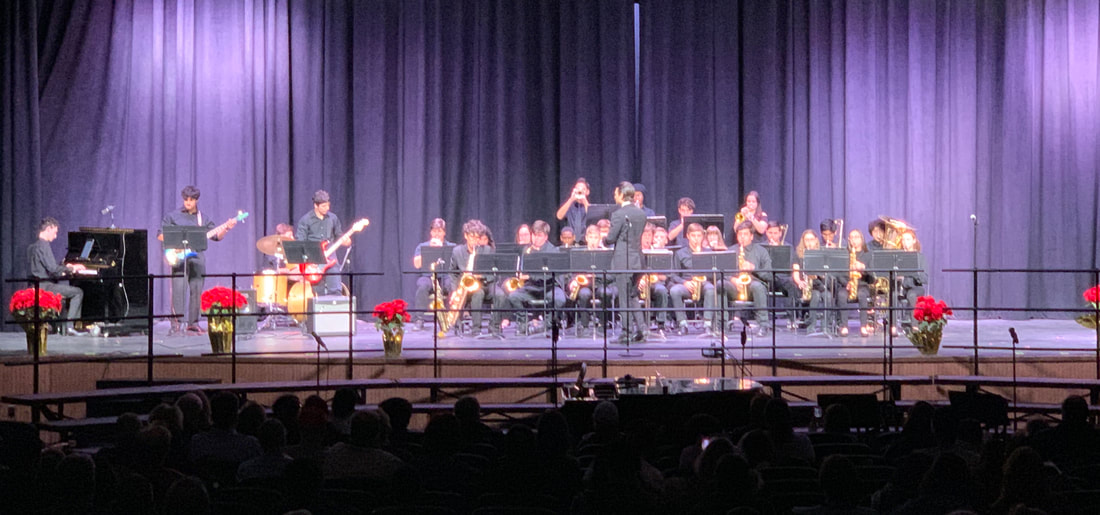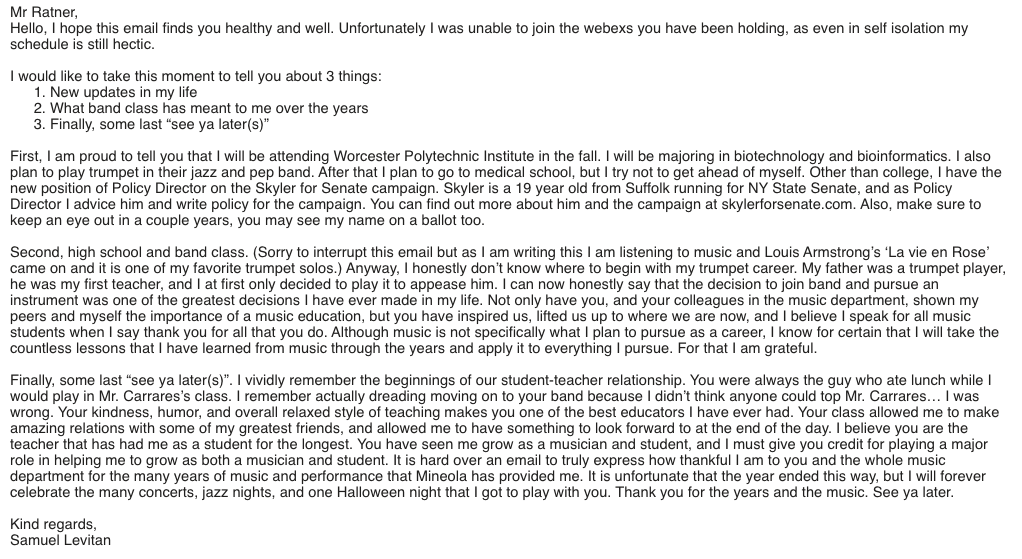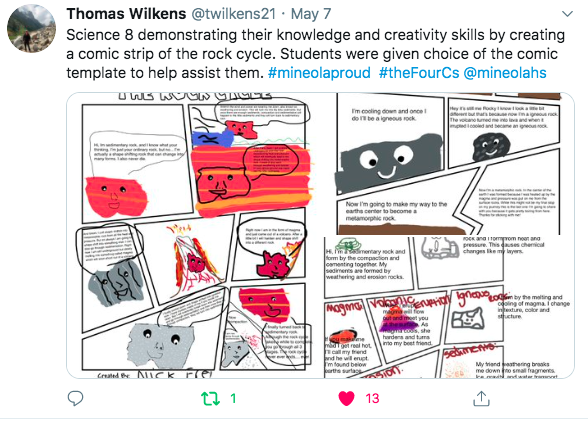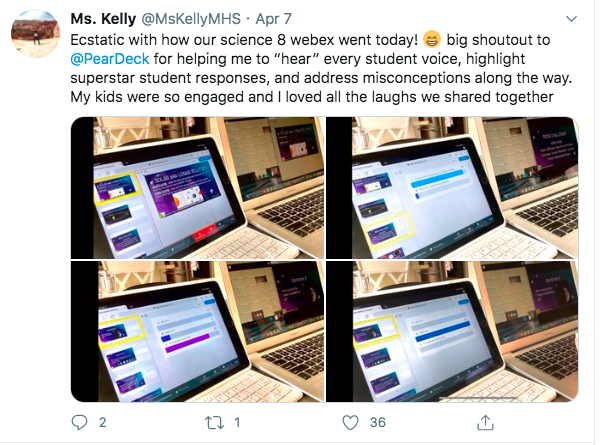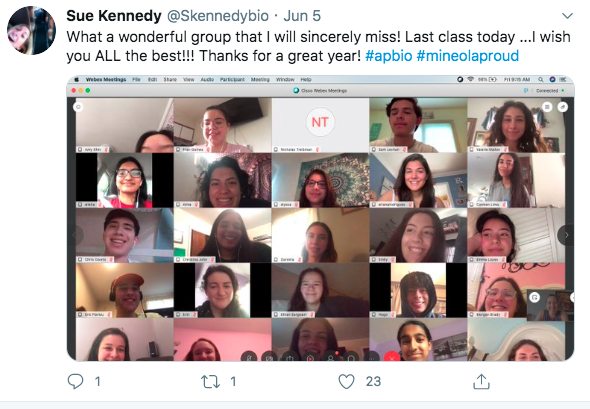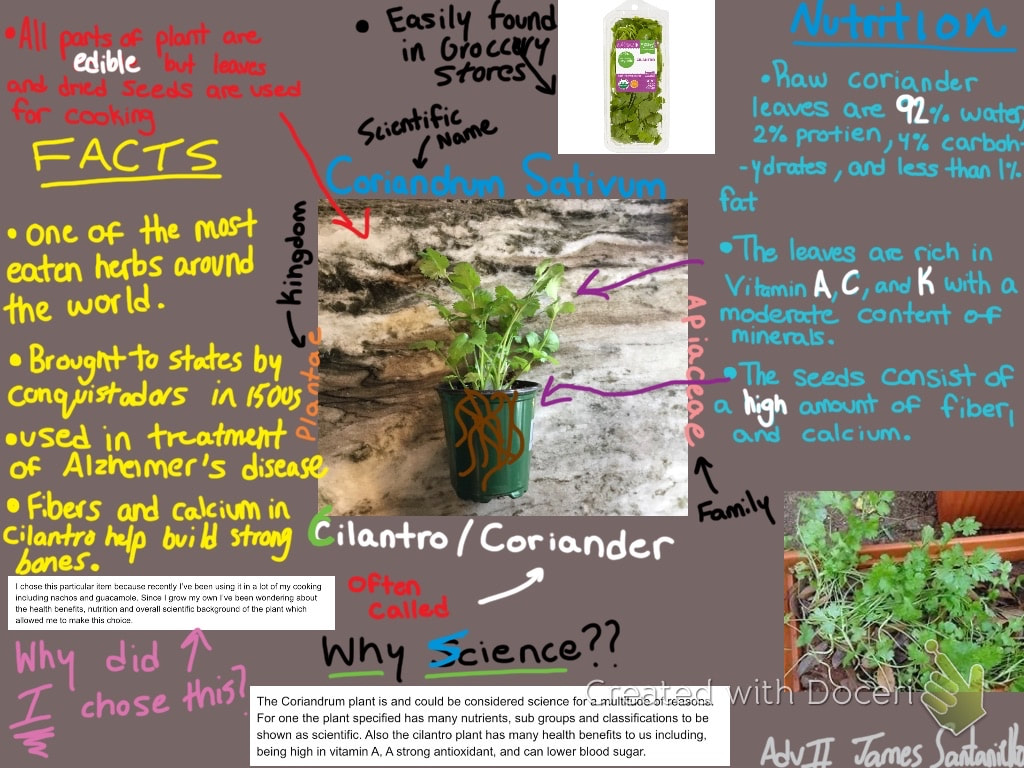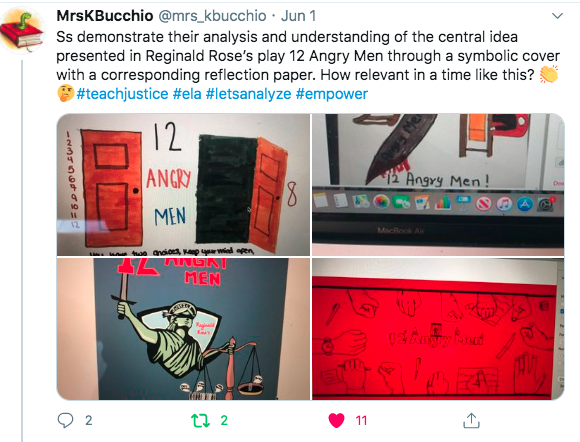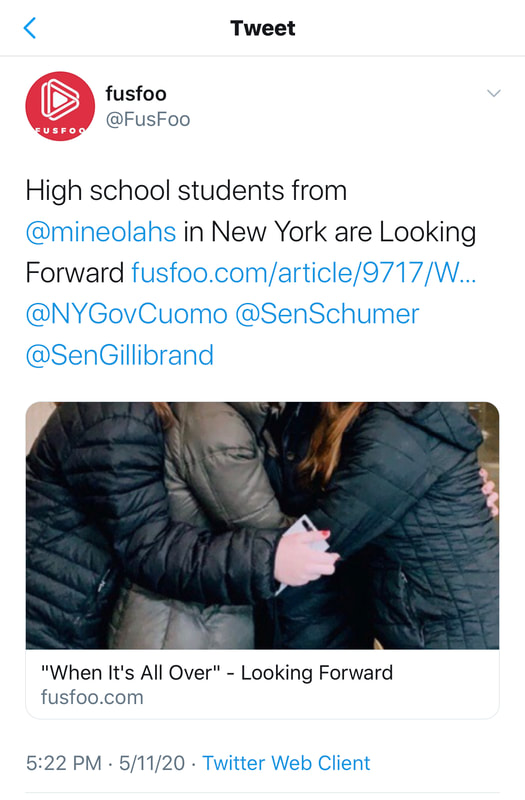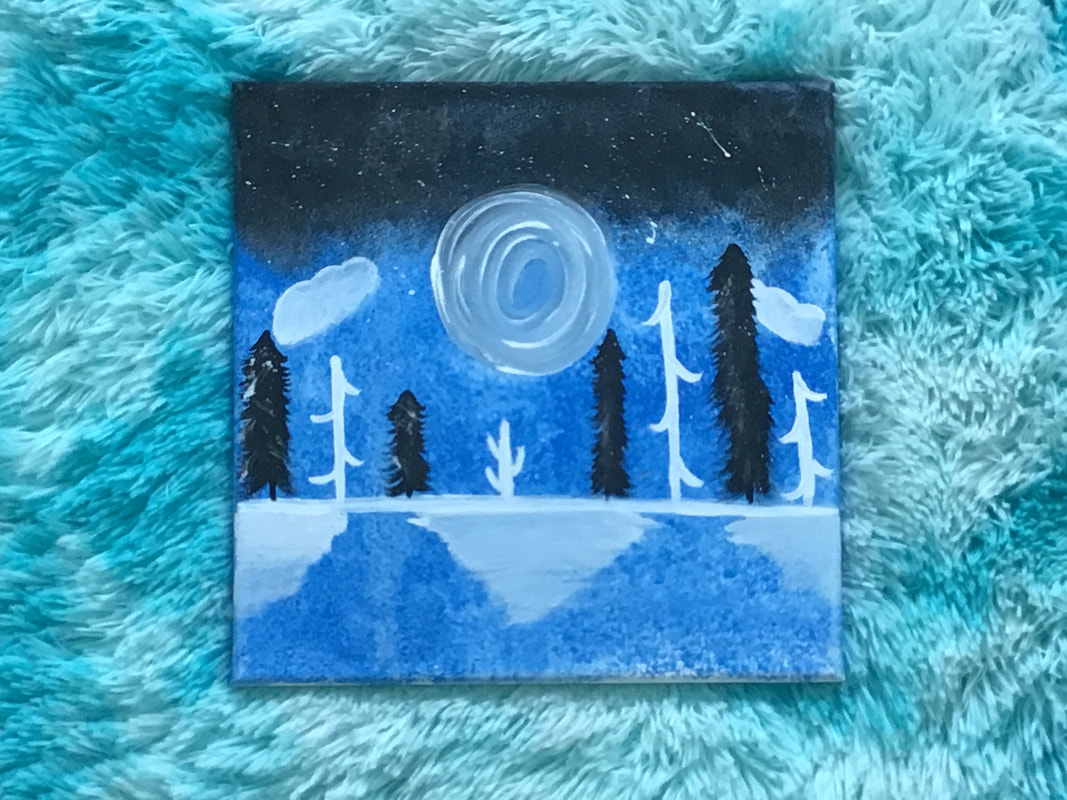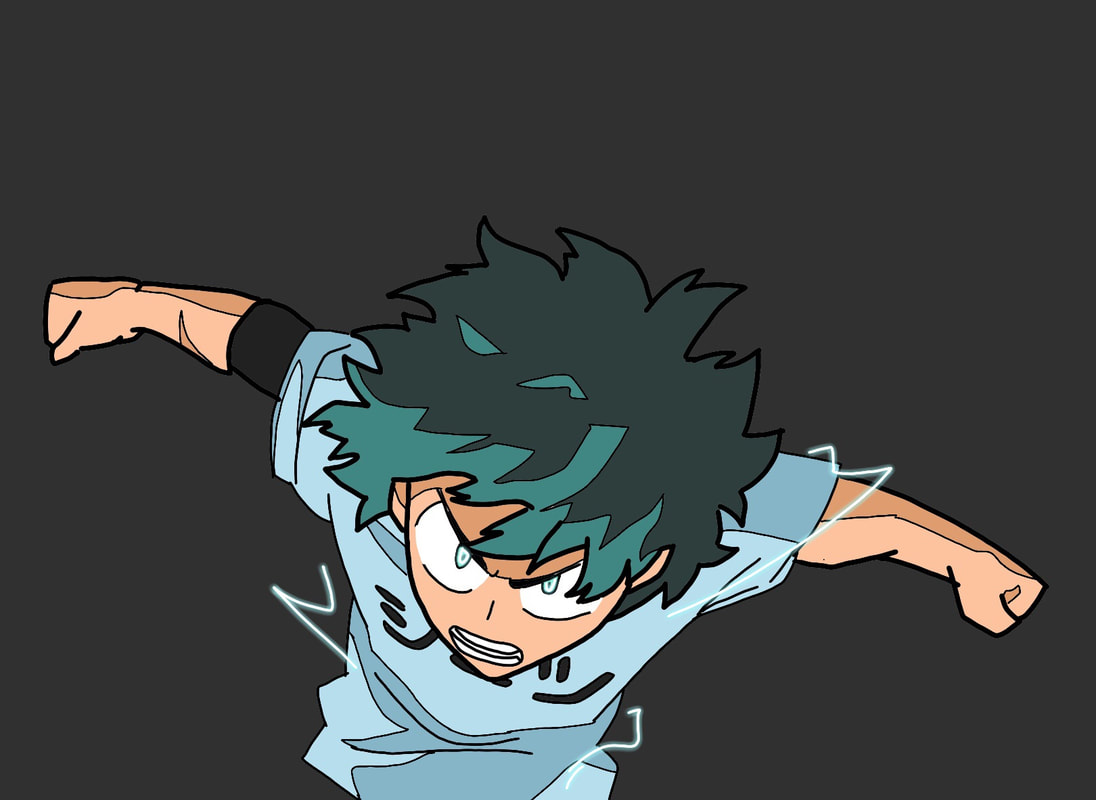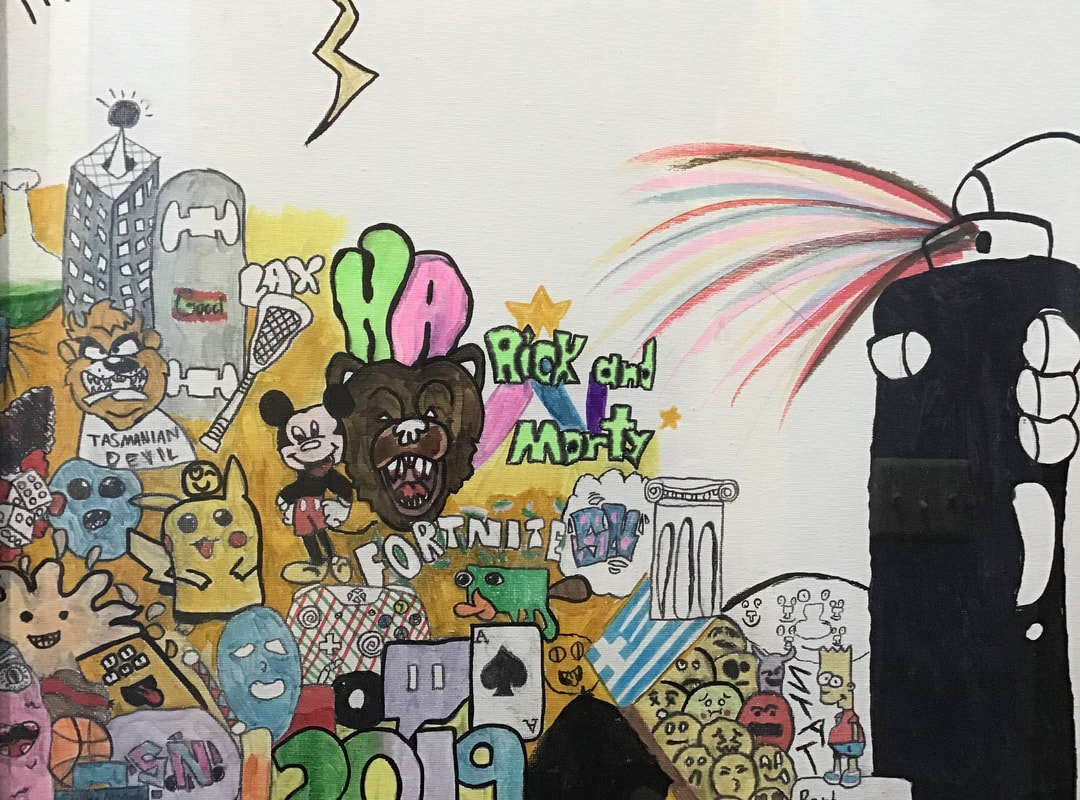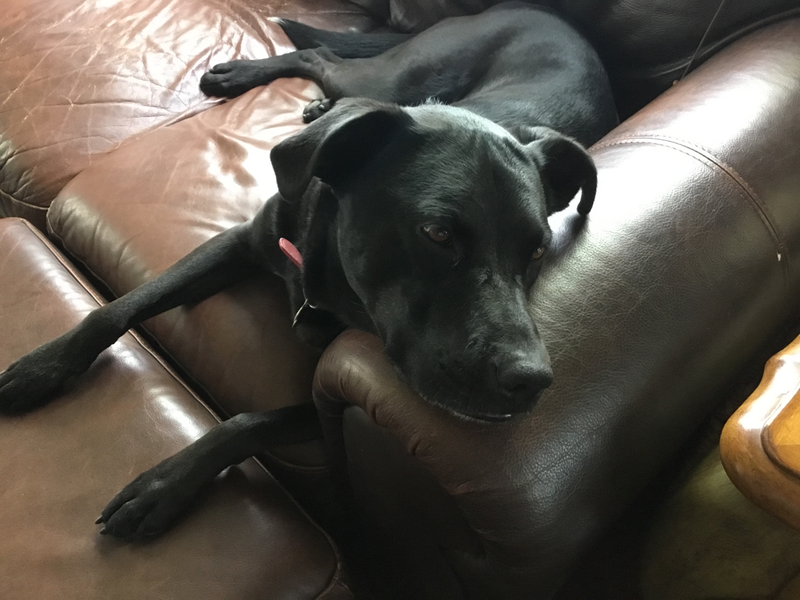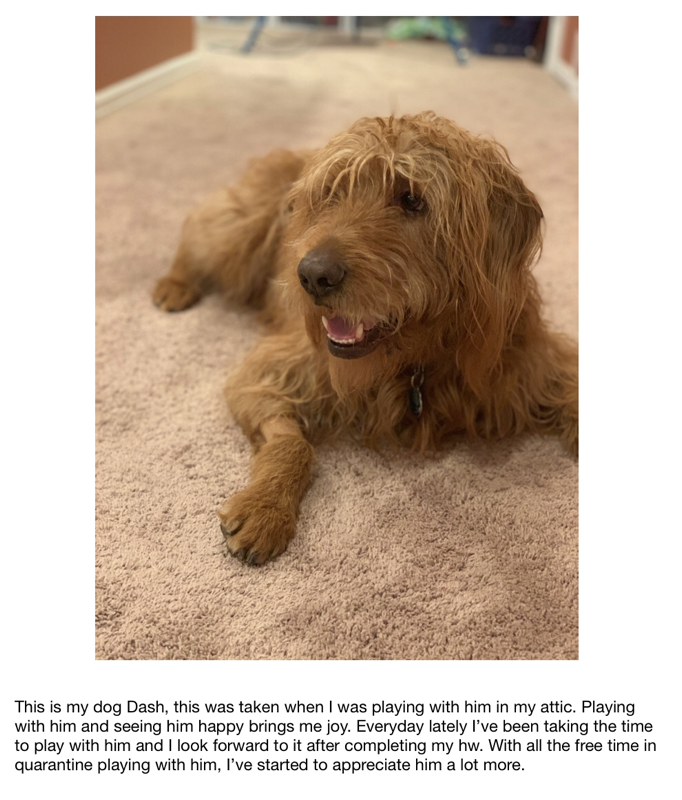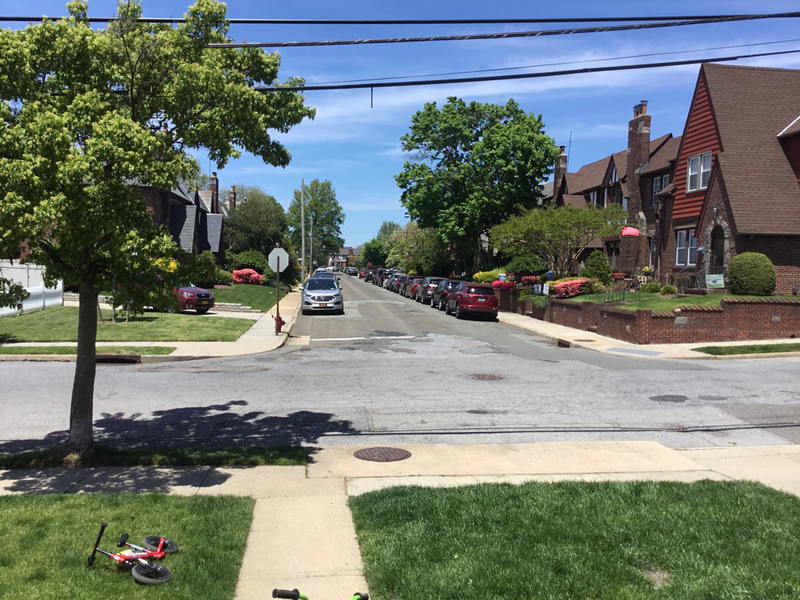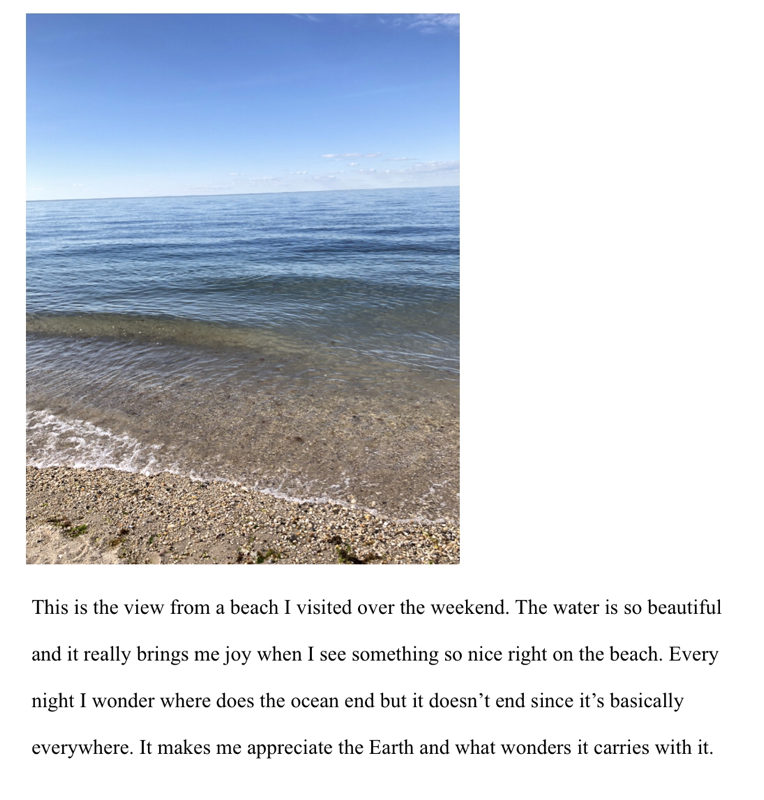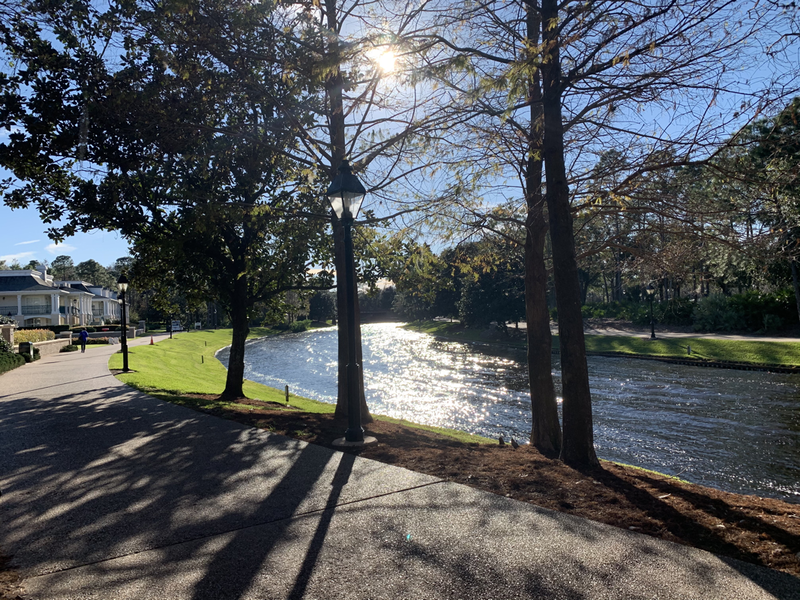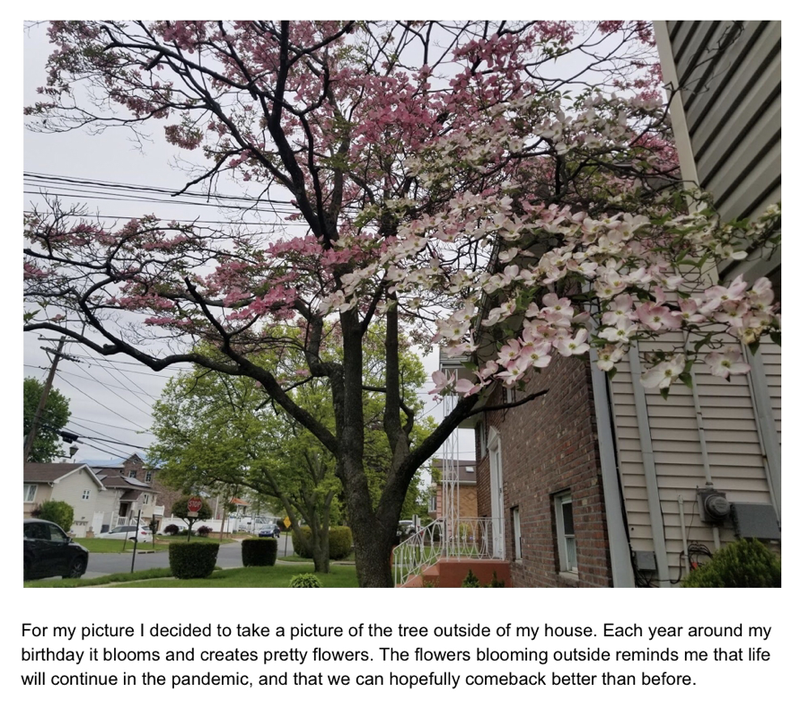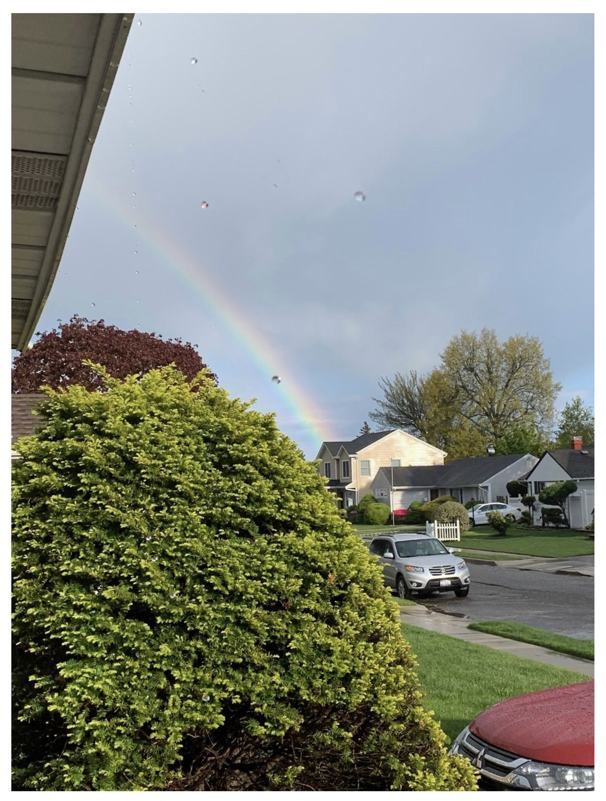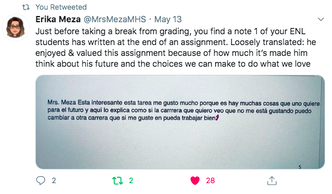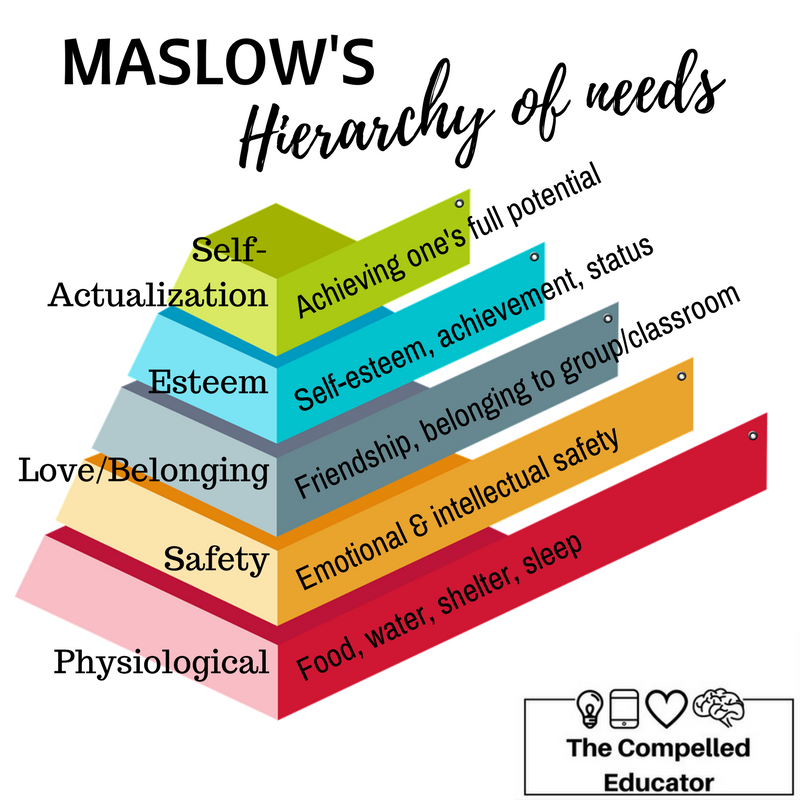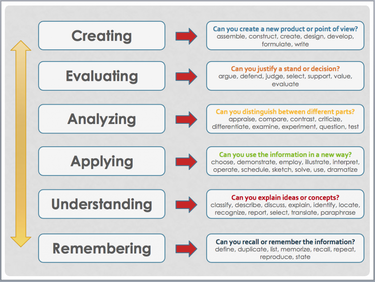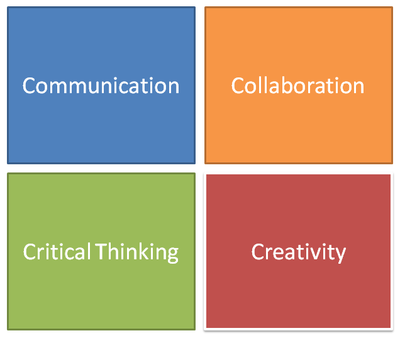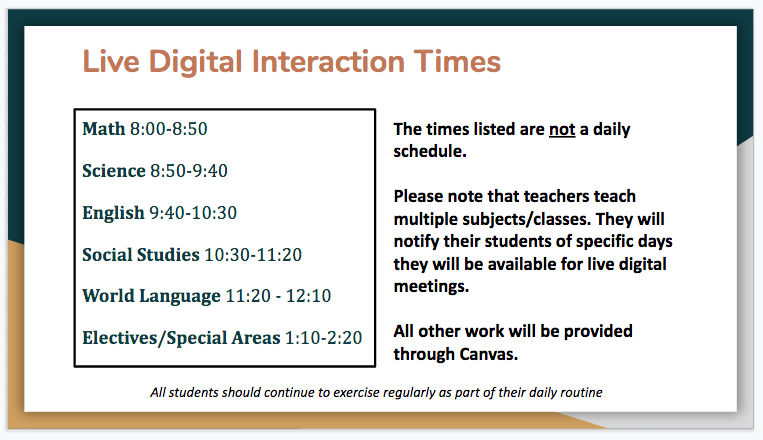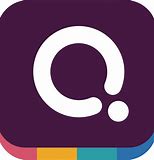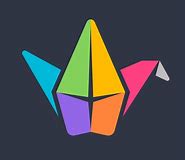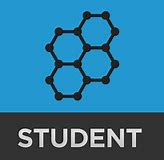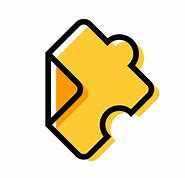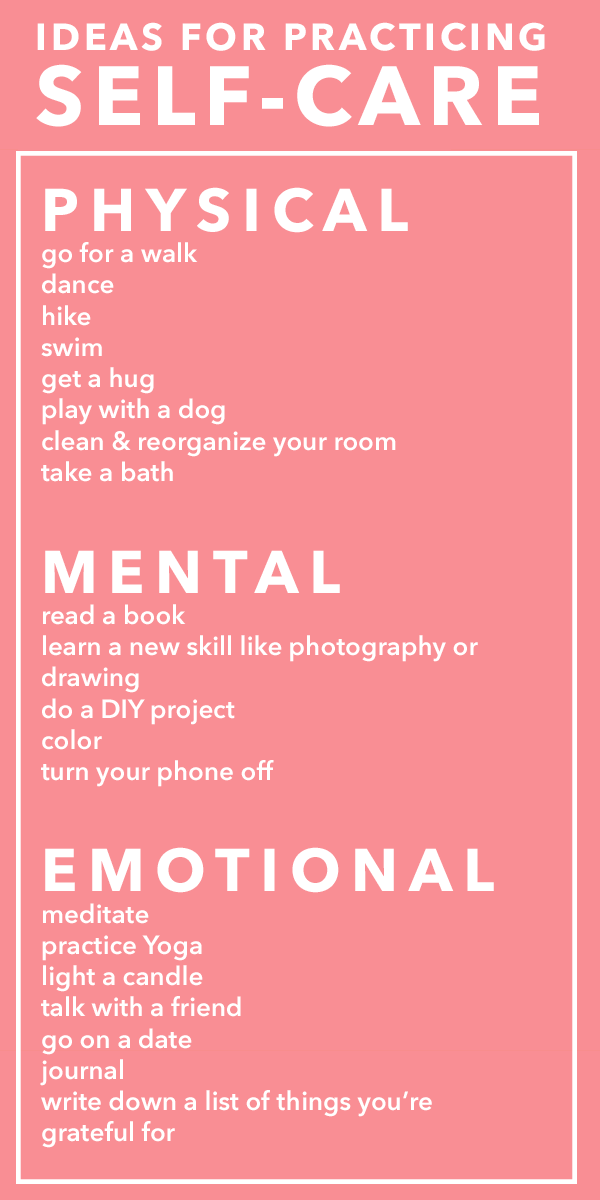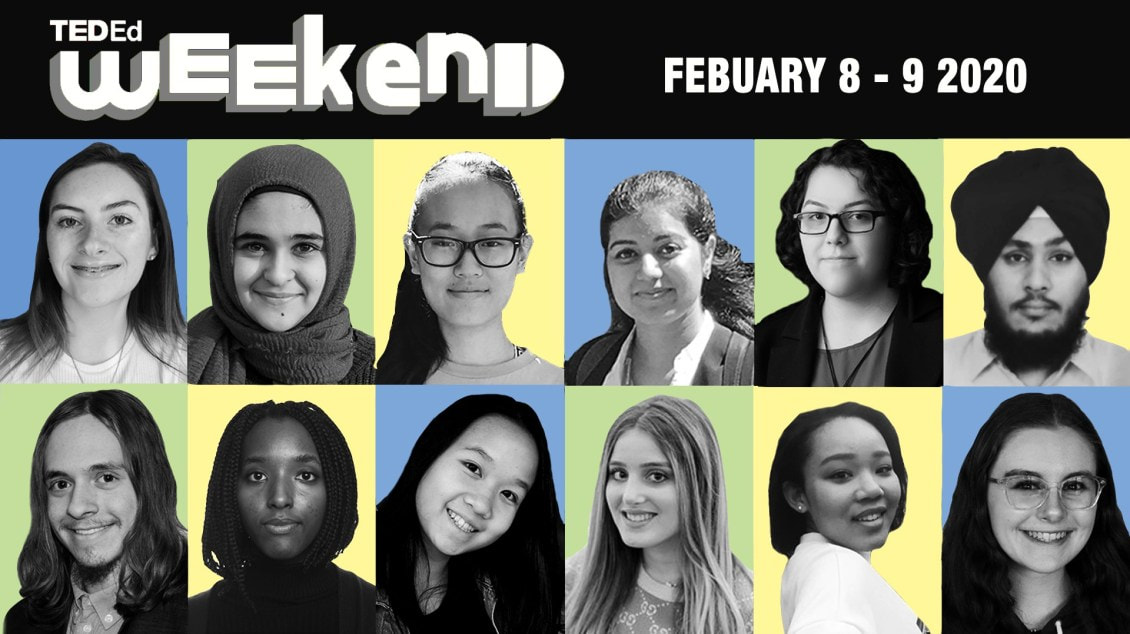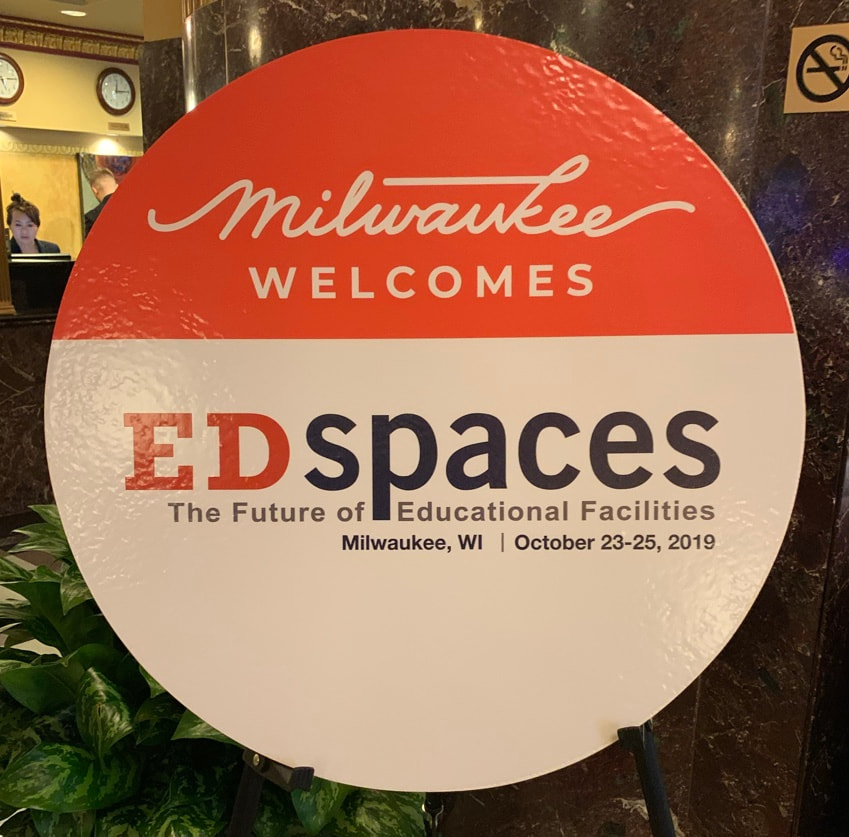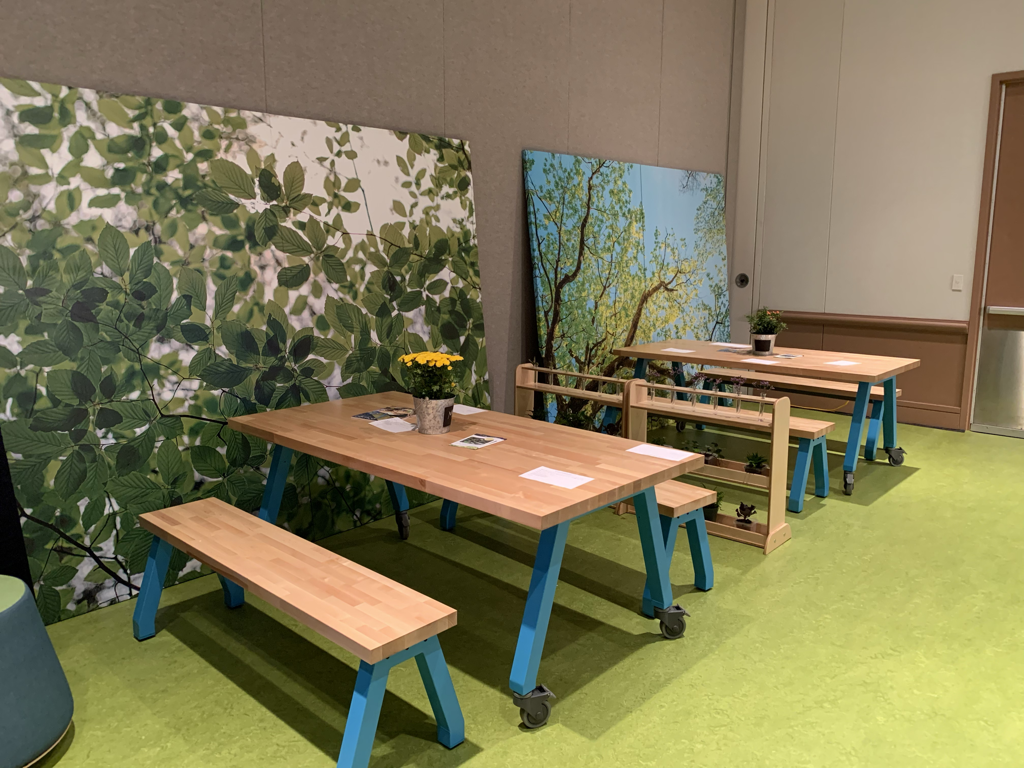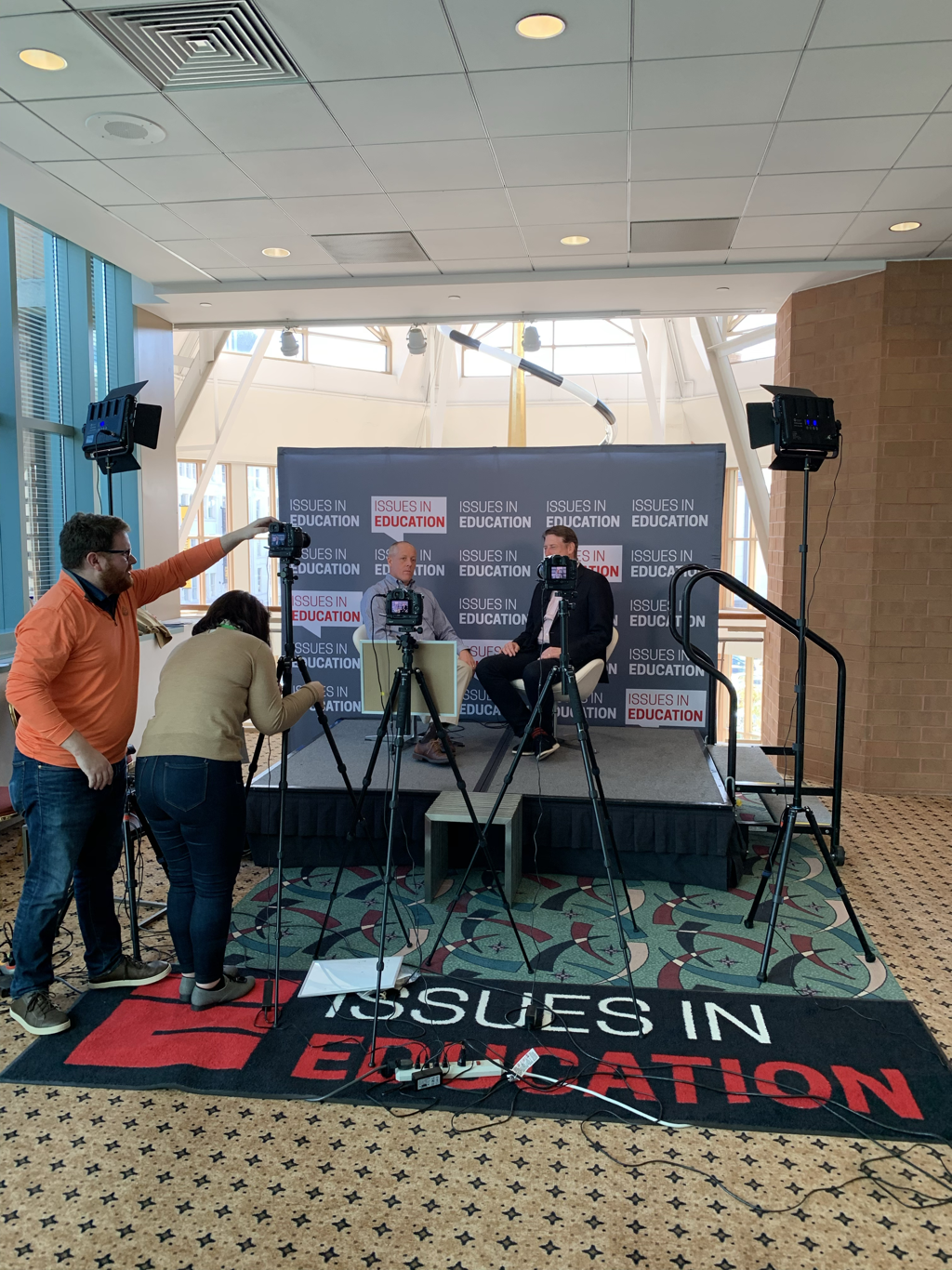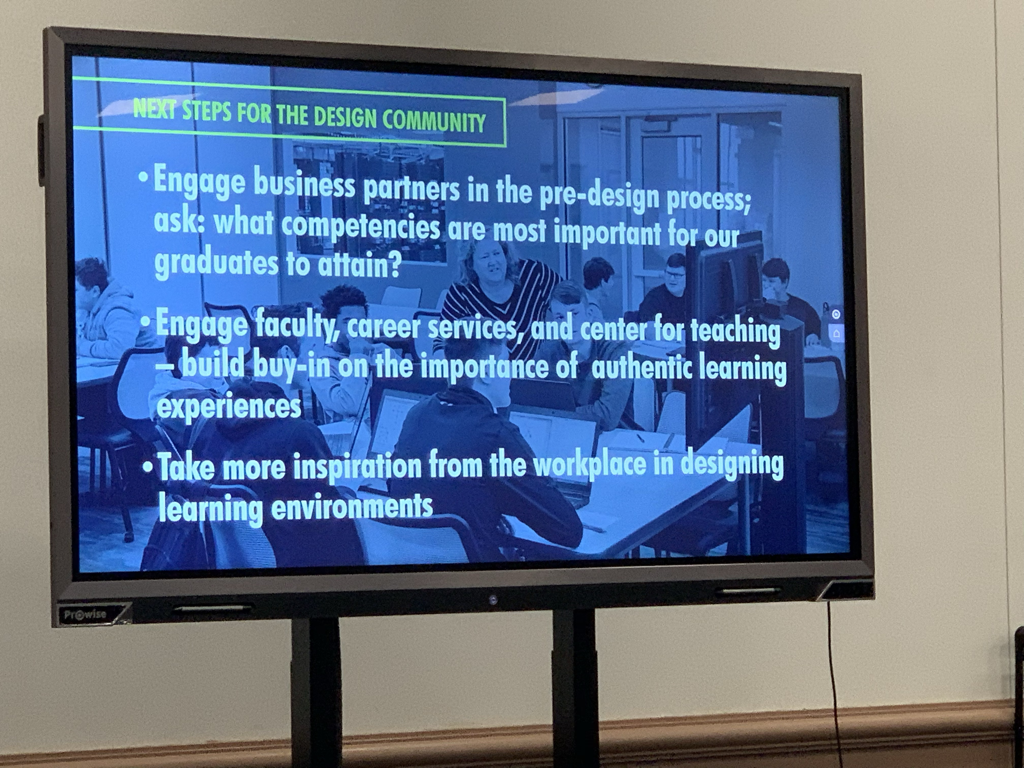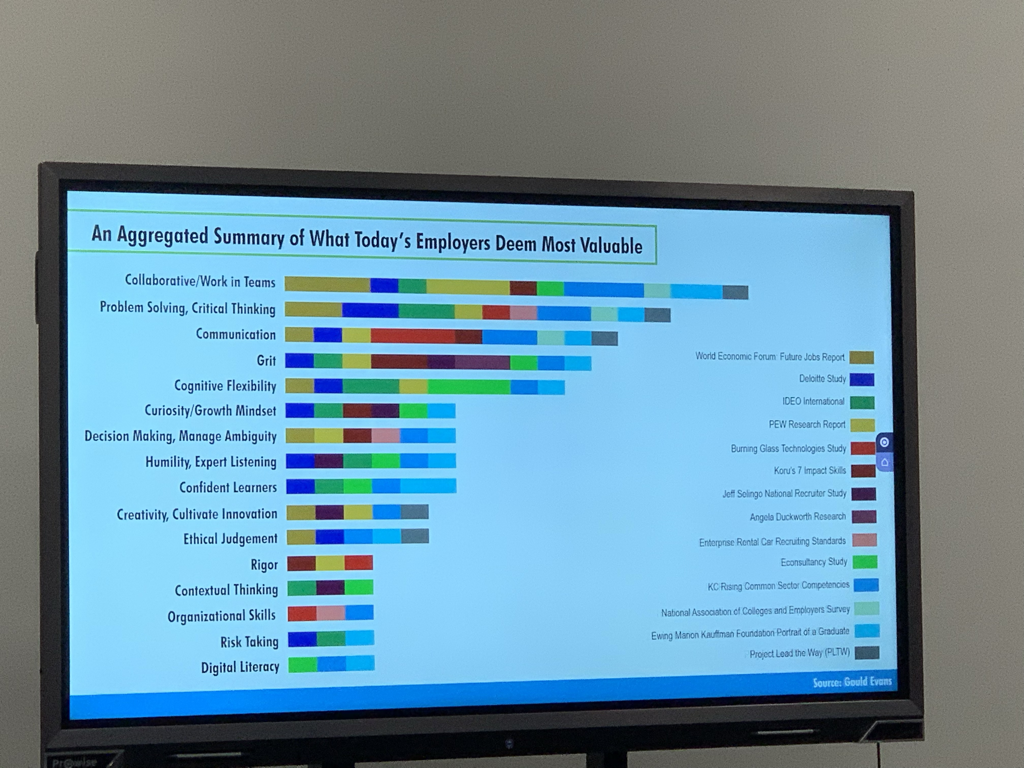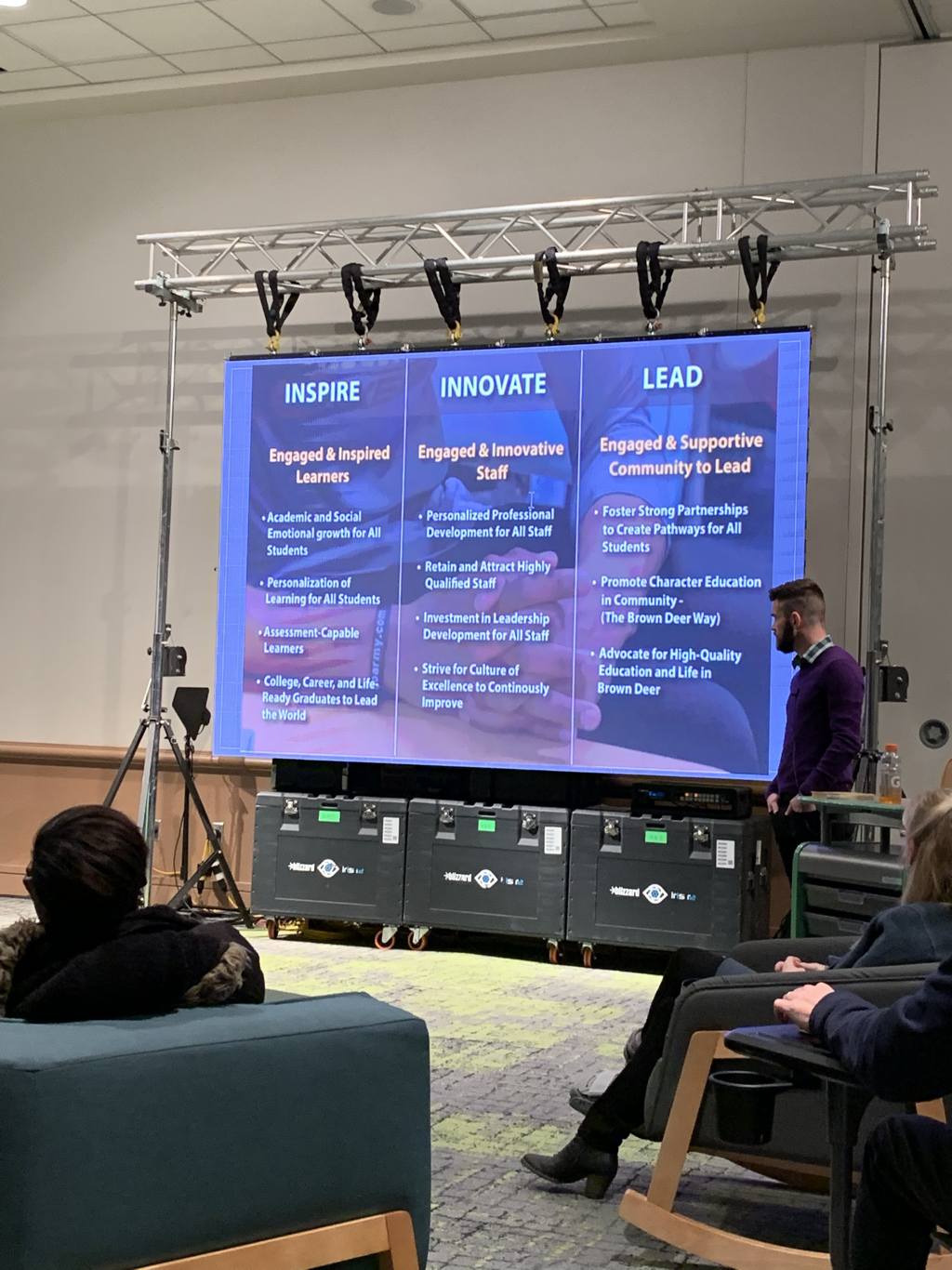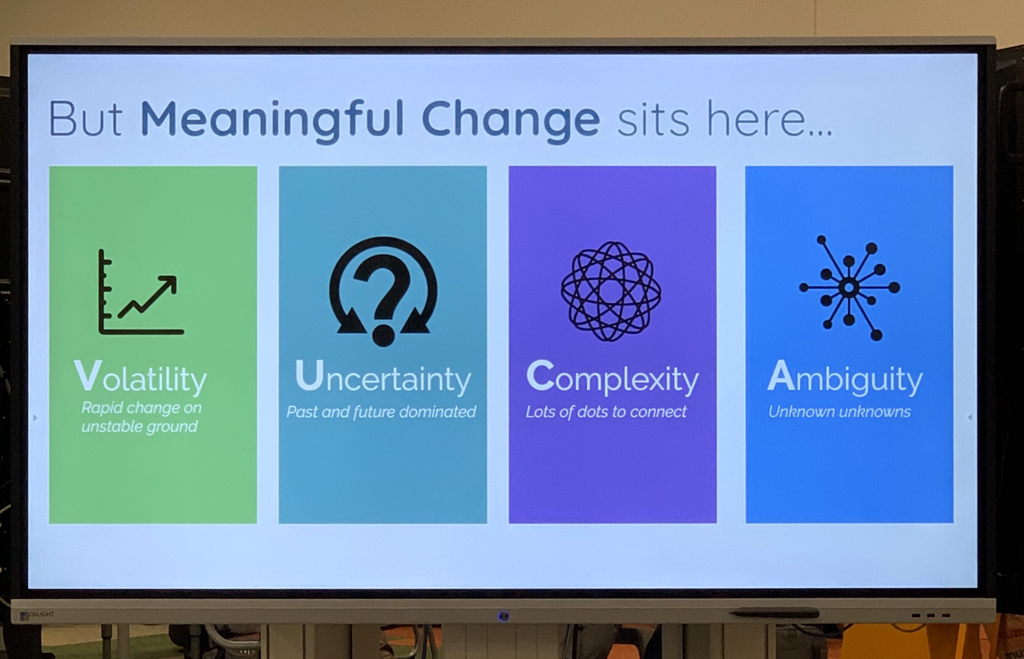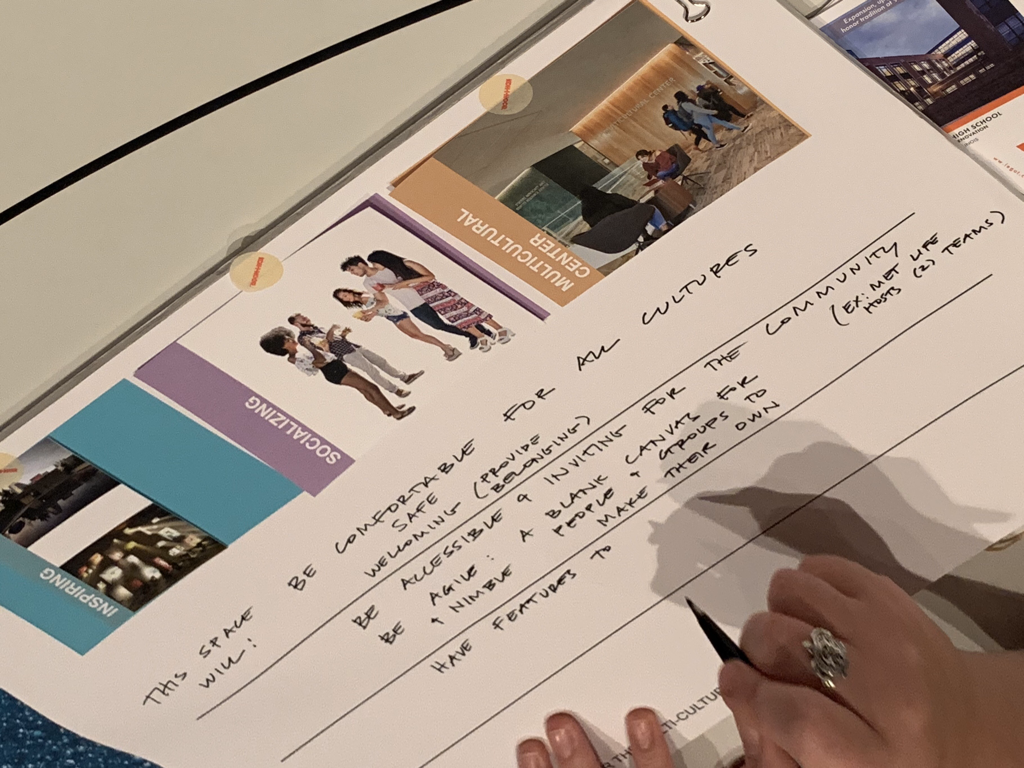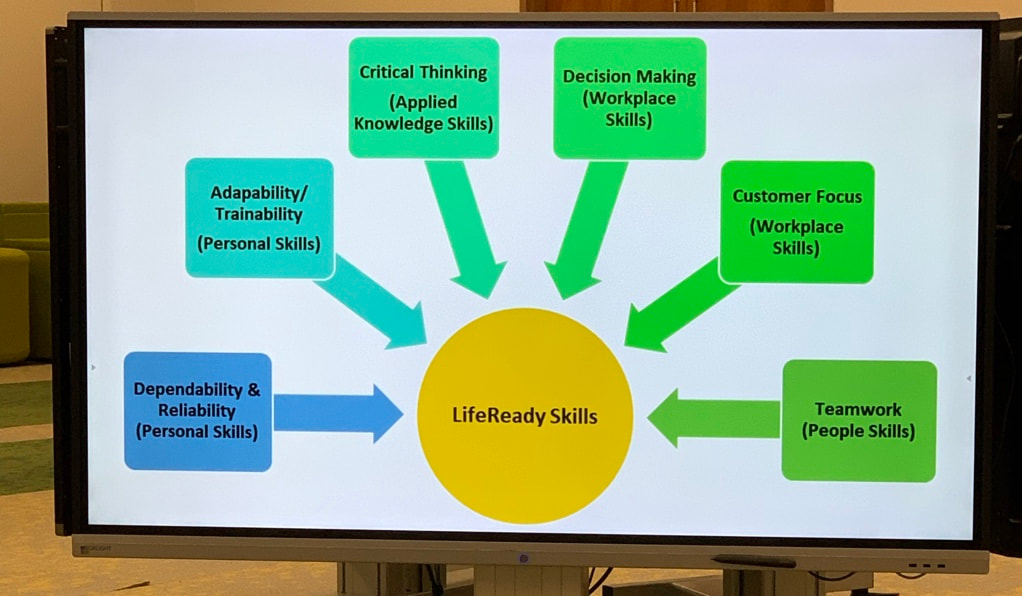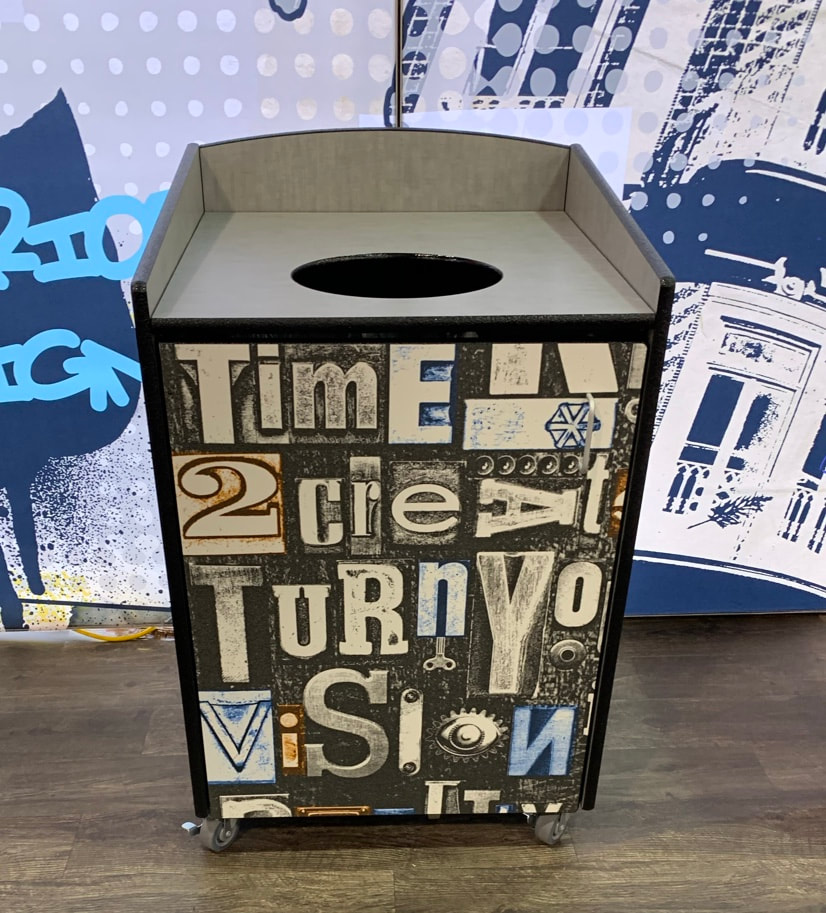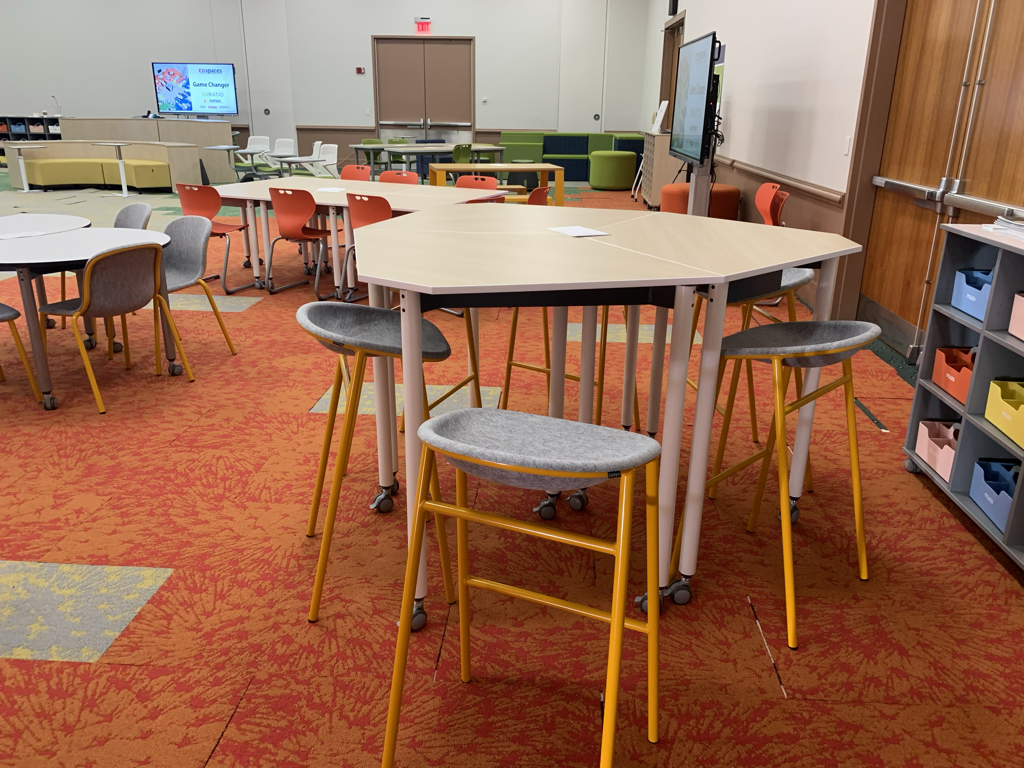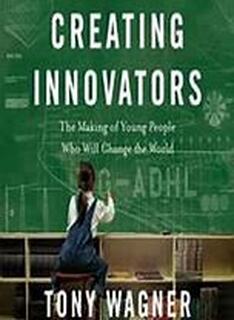|
I am super #mineolaproud to have received the Fred Podolski Visionary Award this year at the 2023 LITES Conference. This award is named in memory of Nassau BOCES’ longtime director of Curriculum, Instruction and Technology. Mr. Podolski was a firm believer in the impact technology could have on student learning. He was also the founder of the Long Island Technology and Education Summit. "This award is given to an educational administrator who has demonstrated vision, leadership and support of technology initiatives. The nominee should have a clear record of driving the use of technology, a demonstrated ability to identify future needs and a passion for serving the educational needs of students and teachers within their school district." What an honor! https://www.litechedsummit.org/Page/129
0 Comments
Good Morning! Welcome Members of the Board of Education, Mr. Gaven, administrators, teachers, our senior class advisors, families, and most importantly, the Mineola High School Class of 2022! What a beautiful day to celebrate this incredible class… together again at the Tilles Center!
I can’t tell you how excited I am to be here with you all this morning! Each year, as I look for inspiration when writing my graduation speech, I often find it in the most obscure locations. This year was no different. I was in Mr. Gaven’s office in the beginning of May and could hear faint music in the distance. The upbeat rhythm caught my attention and I opened the window to see where it was coming from. An instant smile came to my face as I saw our youngest learners, the pre-k kids, with their teachers, practicing a dance outside to Shakira’s “Try Anything” from the movie Zootopia. I thought about their innocence… I thought about how they were just beginning their journey… and I thought about what lies ahead for them in our fast moving, and unpredictable world. When I returned home that evening, I dug into the lyrics… "I keep falling down I keep on hitting the ground But I always get up now…. to see what's next Birds don't just fly They fall down and get up Nobody learns without getting it wrong" This couldn’t be a better descriptor of the past 2 ½ years of our lives… A time filled with both tragedy and triumph. I have thought a lot about time lately… a topic that has allowed me to reflect ever since my dad gave me this pocket watch a few years ago. It was my grandfather’s high school graduation gift, passed down to me, and has been symbolic ever since. Time is a funny thing when you think of it. We are constantly hearing about it… living through it, or affected by it. Whether you’ve been told that you are right on time, it’s about time, you better take your time , or you are living through one strange time, time is a part of you. How often do we think about using our time better, and regret that we didn’t spend it wisely? How often do we wish time could slow down when we are on vacation, or doing something we enjoy? And How often do we wish time would speed up when we are forced to do something unpleasant? Although we cannot literally turn the clock back, or speed it up for that matter, according to Actor, Jeremy Irons “We all have our time machines. Some take us back, they’re called memories. Some take us forward, they’re called dreams.” Your time machines have already created amazing memories together, and now as you step forward in time, you can begin to realize your dreams. So, take control of your time, live your own life, and maximize this valuable and limited resource. By doing so, you will never have to wish that you could go back and fix the things you did or didn’t do in the past. So back to Shakira and our Pre K kids… the song got louder… and even more beautiful. "I won't give up No, I won't give in till I reach the end And then I'll start again No, I won't leave I want to try everything I want to try even though I could fail I won't give up No, I won't give in till I reach the end Then I'll start again No, I won't leave I want to try everything I want to try even though I could fail" Try everything my friends! Don’t ever be afraid to fail. Over the past 13 years, you have come so far and accomplished so much. Remember those accomplishments… the ones you have achieved in the classroom… the ones you have demonstrated in service to others, and the successes you have demonstrated on the athletic fields, courts, and stages across our district. These accomplishments have been nothing short of extraordinary. As you move to the next stage of life, I have a few parting words of advice.
And finally, take the precious TIME you have to Enjoy this one last stop… For it is How you spend your time that will help define who you are… and who you will become. Class of 2022! It has been an honor to be your principal. I am so proud of you all… And I can’t wait to see all you go on to accomplish. At this time, it is my distinct honor to welcome Mr. Patrick Talty, Vice President of the Board of Education.
Children are likely to become enthusiastic, lifelong learners as a result of being provided with an engaging curriculum; a safe, caring community in which to discover and create; and a significant degree of choice about what (and how and why) they are learning. ~ Alfie Kohn Where there are challenging times, there are also opportunities. When the NYS Education Department cancelled the Regents exams, I knew there was an opportunity to address the constraints that many teachers feel around preparing students for a predictable, yet anxiety provoking summative assessment that occurs at the end of every June. I challenged them to teach how they always wanted to and to engage students by making learning real, not just relevant... to have fun! Empower students by providing voice and choice... and shift from traditonal to authentic assessments. After Week 9... I sent the faculty the following request:
Below are just several examples of student work, explanations from our amazing teachers, and anecdotes about learning from our incredible students. What you will see is that learning can be deeper, more exciting, and real when we empower our students. Our challenge is to remember what is working and carry that momentum into the next school year. The examples below are a representation of amazing things going on in our "virtual" classrooms and in the homes of our students. Intrinsic motivation increases, when students own their own learning... Our clubs are meeting as well as, as is our student organization and class officers. School buildings may be closed, but we continue to seize the opportunity to making learning real!
Theater & Dance One of the things that I worried about over the past couple of months doing remote learning was how to still be able to take "performance" classes and still keep them exciting. I think the fact that my students are able to be so vulnerable, and that they trust each other, is what allowed our classes to still do similar things on video as opposed to in school. I really wanted them to be comfortable in front of the camera and the trust we built as a class really helped. The students are presenting, acting scenes, doing improv activities, working out, and dancing together! One thing I really wanted to give them was choice. By giving them choices for projects, such as choreographing a dance number, writing a proposal to put on a show, set/costume and lighting design, creating theatre lesson plans (for our future teachers) and writing scripts/monologues, this allowed them to choose what they wanted to focus on and they were excited to create and share with us! It makes me so happy and excited to see their faces and know that their passion for theatre and dance can still be exciting- even through a screen. Can't wait to be back together again! -Ms. Oliveri (@AislinnOliveri) Science
Science Research The Webex (face-to-face) meetings with students have been awesome. The attendance has been great. I am constantly inspired by the students. They are present and willing to share. Of course some are having difficulties but even those students 'show up' for the class meetings. Here are few of my and my students favorite assignments. Please check out the link below. https://www.sciencemag.org/news/2020/04/scientists-have-turned-structure-coronavirus-music (Links to an external site.) Scientist set the structure of Coronavirus protein to music. Which protein did they use? What aspect of the structure did they use to set to music? Give some details. But why would you set a virus to music? I am looking forward to hear your impressions of music in our next class meeting. Please answer the above three questions either as text or upload your answers in a pdf file. Many students were surprised at how calming the music was. The students were surprised to see that by combining totally different fields (music and science) that scientist could learn about the structure of this protein.
The Crown Education Challenge theme is: Hope during a pandemic. There are three tracks; Art, STEM, and Writing. Your choice! Do not feel obligated to choose STEM. The rapid spread of the coronavirus (COVID-19) is affecting millions of lives worldwide. Schools are closing, cities are locking down, and the economy is slowing. During this difficult time, we must remain hopeful. The Crown Education Challenge aims to encourage students to take a stake in this global challenge by responding to the theme of “hope during a pandemic.” The challenge is open for entries until June 15, 2020 at 11:59 PM PST. Please read the challenge rules (Links to an external site.) for more information. If you have any questions, visit the FAQ (Links to an external site.) page or contact us at [email protected]. Assignments 2 and 3 are included because when I introduced these assignments, the students were very excited. Immediately sharing ideas and thinking about working in groups for at-home science (see examples above). For hope during a pandemic, one of the students is planning on creating a dance to the cornoavirus music from the first assignment. I heard the beginnings of rap songs, seen sketches of drawings and comic strips, and heard the beginnings of a story or scene from a play. I cannot wait to see the submissions. In addition I have attached a presentation video that I ask the Advanced Research II students to upload. - Dr. McGlade-McCulloh (@ellenmc2) Chemistry & Physics Physics and Chemistry teachers collaborated to create a group project for students to complete in lieu of a final exam. Students could choose who they would like to work with as well as what they wanted to do and how they were going to demonstrate their understanding. The groups choose a topic that they learned about this year (see project description below). Then they choose ONE of the following media (see project description below) to express the information and concepts from the assigned unit. There is a grading rubric attached as well. -Mr. Musumeci (@Mrmusumeci_MHS) -Mrs. Adamski (@mrsadamski1) Project examples include a children's story, demonstration videos, comic strips, and a song.
English
Below is my Choice Week Project and some of the assignments I received from my student's. I wish I could send them all, it was the most responsive project to date and I was so impressed, and entertained while viewing their submissions! - Ms. Gross (@MsGross_MHS)
The student and teacher work included in this post are a result of good questions, coupled with a lot of creativity, collaboration, communication, and critical thinking... and this is only a sample. It is time to keep the momentum going and continue to seize the opportunity to make learning real. These skills, along with a sense of community, are the ones that students need right now.
Finally, I leave you with a quote from Tom Murray (@thomascmurray) and a tweet from Mrs. Erika Meza (@MrsMezaMHS) to remind you that as we continue to push toward modern learning and the important skills our students need, we must always remember that remote or live, teaching and learning is all about relationships...
A picture is worth a thousand words. During these unprecendented times, I started to crowd source images from around my community that not only depict the difficulties and extreme struggles felt by many, but also the amazing way our region has come together and helped each other. There is still a lot of good to see in the world... help me add to this journal with pictures from your community!
Be Safe & Stay Healthy!
#WeAreInThisTogether
In high schools across New York State there is always talk of the Regents Exam. This exam has been the focus of teachers since 1878 when the first high school exams were given. On April 6, 2020, that changed... at least for the time being. Now what? I think we now have the unique opportunity to focus on learning, not the test anymore. While we rely soley on remote learning opportunities... our ability to leverage technology will certainly accelarate our ability to focus on student agency. Some cynics will say that without a Regents Exam, the students will not be motivated anymore, they're going to "check out." I don't think so. Instead, I believe we need to seize this opportunity and engage our students. Remember that first and foremost we teach students, then we teach content... and remember, children are naturally curious, want to make connections, and desire learning things that are relevant to them; things that are real.
Now is the time to leverage creation tools. Whether it is a product to create or a problem to solve, allow students to determine how they demonstrate and share their learning.
Now is the the time to shift the paradigm as we are not going to take high stakes, multiple choice tests! Lets do what we've always wanted to do... make learning fun! Remote learning (also called distance learning) requires increased student agency where students will work on their own and at their own pace. Digital technology gives students the ability to continue learning outside of the classroom as well as opportunities to learn from peers, share thoughts, read, watch videos, and interact virtually. Furthermore, it allows the teacher to take on more of a facilitative role while empowering students through self-paced, self-directed learning.
On Your Own & Guided Learning Time (Asynchronous) Asynchronous learning will occupy the majority of learning for students. This will occur through Canvas, our Learning Management System. Students will receive lessons, videos, assignments and learning activities through this platform that will be supplemented with the use of Mathspace and Actively Learn. Additionally, teachers may employ the use of the "tools to increase engagement" listed below. Canvas - our Learning Management System (LMS) will house and distribute announcements, content, assignments, discussions, and videos. Watch the video here to learn how to stay organized with remote learning. Actively Learn - subject area reading resources with built in supports and progress monitoring tools for teachers Mathspace - Interactive, standards and topic aligned math work with built in supports Tools to Increase Engagement We are well poised to continue to use the tools that we have become accustomed to that increase student engagement and promote collaboration, communication, creativity, and critical thinking. The Google suite of apps (Docs, Sheets, Slides) that are part of our workspace accounts in addition to the apps below are just some of the ways our students will continue to stay connected and engaged in the learning process. All of our students have access to our KidOYO platform as well. Computer science students will have assignments and all others are welcome to contiue working on their digital portfolios and additional learning pathways. Of course, this is not an inclusive list, rather just some of the ways that learning will continue to be meaningful for students.
Enrichment Resources Visit over 500 art museums & galleries around the world Curb Your Sports Hunger: Top Sports Movies on Netflix Right Now 20 Screen Free Things to do with Your Kids [or yourself] Indoors When School is Closed Art BINGO (created by Bethany Nugent) Visit 12 Famous Museums offering Virtual Tours Yoga with Adriene pParent Letters:
3/17/20 - Remote Learning Letter to Families 3/20/20 - Update 3/27/20 - Update 4/4/20 - Update 4/7/20 - Update 4/9/20 - AP Testing Updates 4/10/20 - Update 4/17/20 - AP Update #2 4/17/20 - Update 4/24/20 - Update 4/30/20 - AP Update #3 (AP Testing Guide / Exam Day Checklist for Students) 5/2/20 - Update 5/9/20 - Update 5/16/20 - Update 5/18/20 - AP Update #4 5/22/20 - Update
To sum up my time at Ted-Ed, I am always inspired by our students when we give them the opportunity to explore their passions. We must continue to amplify student voice and provide increased opportunities to provide choice in terms of learning. Congratulations to Jennifer Moglia and thank you to Lindsay Audiino, Bette Sloane, and the entire Ted-Ed team for cultivating a rich student centered program that celebrates the power of our youth. As our hosts from Ted-Ed reminded us, “The youth are changing the world... now.”
Below are my notes and takeaways from my learning at EDspaces2019. The conference, held in Milwaukee, WI this year, "the place where technology, space, and pedagogy converge." It was a great opportunity to see learning environments and hear from expert designers, architects, and educators.
Outdoor Learning in an Early Childhood setting Nate Bosch - Landscape architect with GMB
European Forest schools - in Chicago Illinois as well Richard Louv - Pioneer of connecting back to nature academic environments becoming treatment spaces Little Hawks school - Holland, MI
Tips:
21st Century Workplace Competencies: How can design shape student success? Gould Evans
mentoring influences) brought him to several conclusions, among them were that the skills you need to succeed in a competitive academic environment are not related to innovation era. What must we do differently to prepare students for the innovation era?
Next, Wagner identified 5 contradictions in education:
When I recently drove across the Throgs Neck Bridge and noticed that the toll booths had been replaced by fancy overhead structures with cameras and flashing lights, I couldn’t help but wonder… what happened to the toll takers? If you do a Google image search, you will have difficulty finding any pictures that document the removal of the booths… they just disappeared; well, not exactly (as you can see I don't get out much). If you do travel that road every day and see the change happening, then it is not such a surprise. However, as someone who does not regularly travel over the bridge, and many don't, I woke up one morning, drove over the bridge from Long Island, and realized the landscape has changed; and with it, many jobs that used to exist. I think of this as a metaphor for education. If we don’t look at the changes that are happening around us and do something to prepare our students while educating our communities, then change will always come as a surprise. As a high school principal, it is important to me that we seek change and offer opportunities for our students that prepare them for the world outside of our schools. We must continue to innovate and prepare students for a “modern world,” a world where our students will face opportunities and challenges that are developing at a rapid pace. If you notice, I chose the term “modern world’ purposefully as we are nearly 20 years into the 21st century. The skill sets that students need today and the jobs that will be available for them are drastically different than the world I grew up in. 2022 Skill Outlook
Source: Innovate Inside the Box (information taken from the World Economic Forum) This should lead us to think differently about the purpose of school and the goals we have for ourselves and for our students. How are we preparing our students?
 The Fourth Industrial Revolution is upon us and we cannot simply focus on the basics or rote learning. Simply knowing the facts isn’t enough. We must remain, as my drive over the Throgs Neck Bridge demonstrated, ready for change or we risk becoming irrelevant, or worse... obsolete. “Our job is not to prepare students for something. Our job is to help students prepare themselves for anything.” - AJ Juliani (Empower)
|
Categories
All
Archives
October 2023
Whittney Smith, Ed.D.Dr. Smith is the Principal of Mineola High School in Garden City Park, NY. He is also an Adjunct Professor in the Ruth Ammon School of Education at Adelphi University. |
|||||||||||||||||||||||||||||||||||||||||||||||||||||||||||||||||||||
